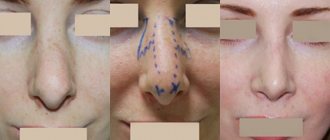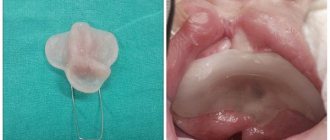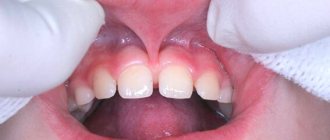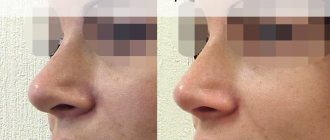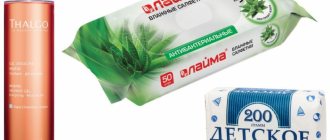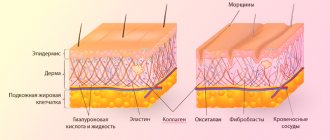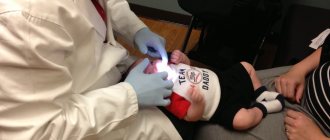Types of seams
To understand how to remove stitches at home, you should know how they differ. Sutures are divided into embedded and removable. Removable sutures are removed after the edges of the wound have fused and are characterized by high strength. They are made on the basis of synthetic and natural materials (mersilene, silk, linen, nylon, nylon), metal staples and wire. Immersed (non-removable) sutures are made from catgut - a natural material made from the small intestines of sheep and capable of dissolving after some time. The advantage is that they are not rejected by the body. Disadvantage: low strength.
Why did you sew up the hole after tooth extraction?
If stitches were applied after wisdom tooth removal, this will only be beneficial. Repeated studies have proven that a sutured socket is:
- reducing the risk of infection and complications - by 90%;
- rapid stop of bleeding;
- preservation of the blood clot and natural healing of the wound;
- minimal pain after surgery;
- rapid fusion of tissues thanks to sutures.
Sutures are placed on the socket immediately after the removal operation. After which the doctor gives recommendations for accelerated healing and rapid normalization of the general condition.
Determining factors
How to remove postoperative sutures at home? The moment of removal of postoperative sutures directly depends on a number of factors, namely:
- the patient's well-being;
- nature of the operation;
- complications;
- characteristics of the disease;
- patient's age;
- restorative features of the body.
The fixing material is foreign to the body. Therefore, to avoid the onset of the inflammatory process, sutures should be removed in a timely manner. How to remove stitches at home? It is not recommended to do this at home due to the possibility of infection, which puts the patient’s life at risk.
Technologies for tightening SMAS and platysma (neck muscles)
If facial plastic surgery is limited to skin tightening only, without touching the underlying tissues, the effect will be insufficient and very short-lived. Therefore, during such operations it is necessary to pay special attention to tightening the so-called SMAS layer.
I like to say that the patient has nothing superfluous. With age, the vast majority of patients experience not an excess at all, but, on the contrary, a deficiency of tissue. Therefore, in such cases, the most suitable SMAS lifting technique is the duplication technique, in which we do not “cut off” anything and do not “throw away” anything, but only remodel the face. Due to redistribution, careful fixation, and strengthening tissue “firmware” SMAS, it is possible to re-create those lines and volumes that were characteristic of faces in youth. Thus, we recreate the beautiful lines of “high” cheekbones, clear V-shaped contours of the oval of the face and chin.
In some cases (round face, presence of a large excess of fatty tissue), the SMAS layer can be lifted by redraping it with partial excision and duplication.
The choice of method for each patient is individual. It all depends on the structural features of the facial bones and the type of face.
Timing for suture removal
How to remove stitches at home? What are the consequences of late or premature removal of sutures? When this manipulation is carried out later than the recommended period, the patient feels discomfort and tension at the suture site. Then tissue ingrowth and wound decay may occur, which will negatively affect the appearance of the scar. It is dangerous to remove stitches ahead of schedule: the edges of the wound may not have time to heal.
- after 12 days - with amputation;
- after 6 days - during surgical operations on the head;
- a week later - after a minor opening of the abdominal wall and 9-12 - during deep surgery;
- 10-14 days - for surgery in the chest area;
- 14 days - for surgical intervention performed on elderly people, weakened by diseases and infections, cancer patients (due to a decrease in the regenerative capabilities of the body);
- 14-20 days - after birth;
- 7-10 days - after cesarean section.
Mistakes of plastic surgeons. why I don’t recommend a vertical lift.
Many foreign (and after them some domestic) plastic surgeons have recently preferred a tension vector directed vertically upward. However, the use of this technique often leads to a catastrophic change in facial features, not to mention the fact that such a lift does not give the desired result in the neck area. But it is the neck and lower third of the face that are one of the main areas requiring correction.
Distortions after a vertical lift are especially characteristic of high-cheekboned, typically Slavic faces. The result is a characteristic deformation - the so-called “Mordovian face” (I apologize in advance to representatives of this nationality). With such deformities, it is impossible to achieve a natural plastic result even with perfectly executed and completely invisible scars.
How to remove stitches at home
Sometimes it happens that for some reason there is no possibility of going to a medical institution. If the recommended healing period has passed, the wound looks prolonged, how can you remove stitches at home for a person who has never encountered this process before, is afraid and does not understand the sequence of actions? In this case, it is important not to panic, to use all your composure and utmost care. First of all, it is necessary to remove the bandage from the wound and make sure that it is not dangerous to remove the suture. If redness or signs of an inflammatory process are detected in this place, you must refuse to remove the sutures yourself and be sure to consult a doctor, since, most likely, the wound has become infected.
Detachment is the decisive stage of the operation
It is extremely important to find its optimal parameters. The correct location, geometry of the incisions and accurate determination of the depth of detachment of facial tissues guarantee the preservation of full blood circulation in the operated area. Too superficial a skin detachment will impair the nutrition of the flap, and an excessively deep one will affect the superficial muscular aponeurotic layer (SMAS), which needs a separate tightening. Only a scrupulously verified and precisely executed (at the same depth over the entire area of the flap) detachment will make it possible to maintain sufficient blood supply to the tissues, which will ensure rapid healing and help achieve a good rejuvenating effect with complete invisibility of incision marks - the main condition for the formation of an “invisible” suture.
How to achieve maximum rejuvenation effect? How far toward the center of the face does the surgeon need to move when removing a flap of skin? If the width of the detachment is too small, the rejuvenation effect will not be sufficiently pronounced and long-term, and if its width is too large, necrosis of the peripheral zones of the skin flap may begin. To determine the correct proportions, the well-proven method of mathematical calculation proposed by the Russian surgeon Limberg (who is considered abroad for some reason to be a specialist in the field of mathematics) is used all over the world. Thanks to his calculations, we manage to avoid many negative consequences.
Preparatory process
At the preparatory stage, you should select the tools that will be used to remove the sutures. So how to properly remove stitches at home?
You will need sharp scissors (preferably nail scissors) and tweezers. It is highly not recommended to remove stitches with a knife. It would be ideal if, instead of homemade scissors, you have real surgical scissors on hand. The tools at hand should be sterilized: put them in a pan of boiling water for a couple of minutes, then take them out, put them on a clean towel and let them dry.
Additionally, it is recommended to wipe them with alcohol. It is also necessary to treat your hands with antiseptic. These measures will prevent infection from entering the wound. Next, you should prepare sterile bandages and ointment containing antibiotics in case of possible bleeding.
The area where the stitches will be removed should be washed with soapy water and wiped with a clean towel. Then wipe with cotton wool soaked in an alcohol solution. The main process should be started by making sure that the skin around the stitches is clean. How to remove stitches after surgery at home?
Suturing the gums after tooth extraction: when required
On the eve of a surgical operation, patients are often interested in whether it is necessary to apply sutures after removing a tooth - wisdom, canine, incisor. There are certain indications for gum suturing:
- Dental implantation. When choosing a one-stage tooth restoration protocol, the patient must undergo two surgical interventions at once. This is tooth extraction and immediate implantation. In order for the dental implant to take root in the bone tissue without any problems, the doctor will apply sutures and leave the implant in the tooth socket.
- Removing eights. Wisdom teeth are characterized by enlarged roots, an uncomfortable position in the jaw row, and difficulty in extraction. When third molars are removed, soft and bone tissues are severely damaged, heavy bleeding begins, and severe pain is possible. To reduce unpleasant consequences, the doctor places a hemostatic sponge in the hole and sutures the gums after tooth extraction.
Sutures are also indicated when there is a threat of severe bleeding, extraction of dystopic and impacted teeth. The manipulation is also performed at the patient’s personal request.
Description of the process sequence
The process of removing sutures should be done in a well-lit place in order to clearly see the slightest nuances.
First, use tweezers to lift the first knot not very high. Then use scissors to cut off the base of the thread and begin to carefully pull it out, preventing outer pieces from getting into the fabric. This should be done until the last thread leaves the scar.
The knot should not be pulled through the skin: it will get stuck and cause bleeding. At the end of the procedure, which is relatively painless (except that there is slight discomfort and tingling during the process of pulling the thread), you should make sure that there are no fragments of sewing material left in the wound. To speed up the regeneration of the skin and prevent infection, the scar site should be treated with a weak composition of iodonate, and then apply a fixing bandage.
How to remove stitches from your head at home? It is extremely undesirable to do this yourself in hard-to-reach places, on the head, after a major operation, as this is fraught with a guaranteed infection. Do not wet or wash stitch cuts with soap. You should not try to remove surgical braces at home: doctors do this in a hospital setting with a special tool. If suddenly blood begins to ooze from the wound, you should stop the independent operation and urgently consult a doctor who will help you finish what you started. The appearance of the wound and its healing depend on the accuracy of the sutures and the timely removal of them. Therefore, it is advisable to have the stitches removed by a medical professional.
Mistakes of plastic surgeons. why you can't hide the seam inside the ear.
Since 1913, from time to time plastic surgeons have had the “brilliant” idea of placing the incision not in front of the tragus, but behind it. In this case, the scar will be located inside the ear and will become completely invisible. It would seem like a simple and ingenious solution!
But sometimes not everything is as it seems... With such cutting, the skin of the cheek is pulled over the tragus. As we have already said, it differs significantly from the paler and thinner skin around the auricle in structure, thickness, and shade. Therefore, even people who do not understand anything about anatomy and aesthetic medicine will notice some subtle oddity in appearance. Such a face will always look unnatural to some extent!
What’s worse is that in this case, improper redistribution of the weight of the tissues of the buccal area occurs. The entire load falls on the thin tragus cartilage. Because of this, its deformation and even gradual resorption are often observed. After 2-3 years after the operation, the tragus may disappear completely, and ears with an open ear canal will have to be constantly hidden from prying eyes.
How to remove suture threads from a tooth socket
Many people associate the removal of sutures with unpleasant pain. Pain occurs only in people with a low pain threshold, increased sensitivity, or when there is inflammation in the tooth socket. Usually the patient experiences only discomfort.
Stages of removing suture material:
- treating the patient's oral cavity with an antiseptic;
- examination of the mucous membranes for hyperthermia, swelling, suppuration;
- the use of topical anesthesia to prevent even minimal pain;
- cutting the threads with a special dental instrument - the stitches are divided in half, especially in the case of an intermittent suture line;
- removing pieces of thread with tweezers;
- checking the density of the scar and the quality of wound healing.
Next, the patient will be asked to rinse his mouth with an antiseptic composition.
The first three days after the stitches are removed, stiffness of movements and discomfort when opening the mouth are possible.
